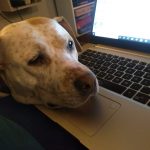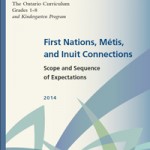
By John Myers, OISE
In the previous issue of Rapport I painted a gloomy picture of the practice of inquiry in classrooms. In Ontario the calls for inquiry in curricula go back to my early days of teaching in the 1970s and way before into the last decades of the 19th century. More than a century ago John Dewey articulated this in How we Think (Dewey, 1910).
This picture is compounded by recent evidence from a major study looking at how students analyze web home pages, evaluate evidence, and assess claims on social media. If these together represent a cornerstone of civic online reasoning, they reinforce the despair many feel in the aftermath of the American election (Stanford History Education Group, 2016*).
So what can we do?
Recognize that the evidence strongly supports the notion of inquiry as a habit of mind or a tool for reflective thought rather than a set of discrete processes or “skills”. Such thought is linked to meta cognition: a key factor in promoting student achievement.
Incorporating a number of directions suggested in both OHASSTA workshops and previous Pedagogical Perspectives (I leave you to explore Visible Thinking, Co-operative Learning, Mystery games, student-generated questions as well as the work from the Stanford History Education Group: all of which offer classroom-ready approaches to try and assess) I offer two additional directions for promoting or, as the TC2 people say, “nurturing” inquiry. The first approach is to get students into the habit of forming their own questions and teachers into the habit of using such questions to promote inquiry.
Snowballing Powerful Questions
“Snowball”, sometimes called “Consensus” (Craigen and Ward, 2004) is a way to help students acquire skills in designing powerful questions for an inquiry. Such questions should:
- be engaging to students,
- be connected to important curriculum goals, and
- require an informed, reasoned answer based on evidence and clear criteria for making a judgment.
Here is an example keeping with an environmental theme
The class is discussing what to do for Earth Day as a part of a unit (geography, science, social studies, health, etc.). They are going to use the local newspaper and/or online media for collecting collect stories, pictures, and other sources as April 22 approaches.
- Individually each student writes down three questions they would like to answer about Earth Day.
- Students pair and compare questions. They come to agreement on three questions they both consider important to answer.
- The pairs combine with another pair. The groups of four come to a consensus on four questions they want answered.
- The groups of four combine and come to agreement on five important questions. This step can be optional depending on your comfort and that of the class with groups of 8.
- Each group puts their questions on the chalkboard, smartboard or an online class management tool such as google docs or socrative.
- With the teacher’s help the class comes to an agreement on 5-6 important powerful questions they want answered about the upcoming Earth Day. As individuals, pairs, or small groups they begin a clipping file on one of these questions in order to develop a thesis to share with the class**.
In addition to increased commitment by students in answering their own questions, you can use these powerful questions as you plan end-of-unit tests or other culminating tasks.
In addition to basing an inquiry on a specific “day” known in advance, you can use it to follow up on a current event or something that grabs student interest that fits your course. For example, decades ago Peel DSB economics teacher Linda Duez had students who were TOTALLY wrapped up in the verdict rendered at the O.J. Simpson murder trial do a cost-benefit analysis of the trial which looked at law and race relations in addition to economics. Student questions triggered this work.
If you use a “visible thinking” lens you and your students can identify:
- what you already know
- what you learn through discussion and comparing responses with others
- working to achieve consensus through comparison and summarization as a class
This structure is a cousin of the K-L-L strategy.
Discrepant Events
The second approach is to promote curiosity through the use of “discrepant events”.
This can be used to spur inquiry through the discussion around discrepant events. Events in which we expect that one thing will happen, and something else happens instead. Psychological constructivists say that these events create “cognitive dissonance”. When we create cognitive dissonance for our students, they should be ready to learn. Discrepant events have been used in science education for decades. Here are some examples.
- Fill one bottle with hot water and a second bottle with cold. Put both in the freezer. Which one would you think freezes first? Which one actually does? WHY?
- Sit in a straight-backed chair. Keep your back against the back of the chair and put your feet flat on the floor. fold your arms across your chest. Now, keep your feet flat and your back straight and try to stand up. You cannot. WHY?
- Spin two eggs – one raw and the other one boiled. You can tell which is raw and which is boiled. WHY?
- Take a crisp new dollar bill and hold it about chest high. Put your hand at about the middle of the bill with thumb and index finger about an inch apart – but not touching the bill. Without warning, let go of the bill and see if you can catch it before it passes through your fingers. You can’t do it. WHY?
We can go into our subject area too.
- In 1492 Columbus found the Americas on his way to Asia. There was no celebration of this event in 1592 or 1692. In 1792 and 1892 there were celebrations in the United States about this great “discovery”. In 1992 the Smithsonian Institution celebrated the event by calling it an “exchange”. It seems history changes. WHY?
- Sometimes polls predicting election results are accurate and sometimes they are not. WHY?
Much of the initial classroom work on inquiry came from science, including the identification of discrepant events that defy the logic of the time. For example the idea that certain moulds killed bacteria was noted in the late 1800s. Years of investigation resulted in the identification of penicillin from one of these moulds in 1928 and another dozen years before the “discovery” would result in mass production of a drug that would save untold lives in WW2. Breakthrough events in science may take months or years of investigation to reach fruition. So the term “breakthrough” may be a misnomer, even though we identify the discovery of penicillin as such. It is the discrepant event that promotes the curiosity and hard work needed to resolve the problem and make sense of it.
Here is a history example that happened in a class where you might not expect inquiry to work.
I was observing a student teacher and his class a couple of years ago. In a world War One unit taught with a grade 10 class working with a locally-developed curriculum course. All students had been deferred from writing the OSSLT due to IEP considerations. At least one was on the autism spectrum, some of the rest were ELLs and we had an Educational Assistant in the room. Based on their curiosity of the scene from the movie Passchendaele of a Canadian being crucified, my student adapted an exercise I had designed decades ago (and currently use to introduce my teacher education course to the challenges of thinking historically***). In my student teacher’s learning task, the gr. 10 students had to read clues and sort evidence into relevant and non-relevant categories and decide if the story being depicted was true.
Though loud and at times almost raucous, the more than a dozen students (official attendance should have been 16) were totally focused on the task for thirty minutes: much better than the less than a minute average attention span in prior lessons. Much of the time they asked each other questions and the student teacher adapted, summarized on the board, and offered prompts rather than definitive answers; after all, they had to figure things out before they could vote on the issue.
“What’s this mean?” “Is this important?” “Are Harry Band and Sergeant Brant actually the same person?” “Was this propaganda?” “Does this clue tell us anything we can use?” were just some of the questions students posed: sometimes to themselves, to neighbours, or to the whole class.
Conclusions and Next Steps?
The story above demonstrated the power of student questions in a struggling class. I had first used the “snowball technique” which I got from a science teacher in a grade five classroom. Inquiry begins with questions to work to get students, like historians, natural and social scientists, to develop their own.
For more on discrepant events in history and social science you can check out the following:
Doing Social Studies: Discrepant Event Inquiry
Endnotes
* Stanford History Education Group takes you to this and many other studies. The tasks and the rubrics seem easily transferable to Ontario classrooms.
** Given questions about media literacy, including social media, some of this work shall appear in a future Pedagogical Perspectives.
*** “Canada’s Golgotha” was a mystery game formatted inquiry I used at a 2015 OHASSTA conference workshop entitled Wrapped in a Mystery.
References
Craigen J. and Ward C. (2004) What’s This Got to Do with Anything? Kagan Cooperative Learning. Access through Kagan Online.
Dewey, J. (1910). How We Think. Boston: D.C. Heath.
Stanford Education Group (2016). Evaluating Information: The Cornerstone of Civic online Reasoning. Access a PDF file from this location. Or read about the study here.


